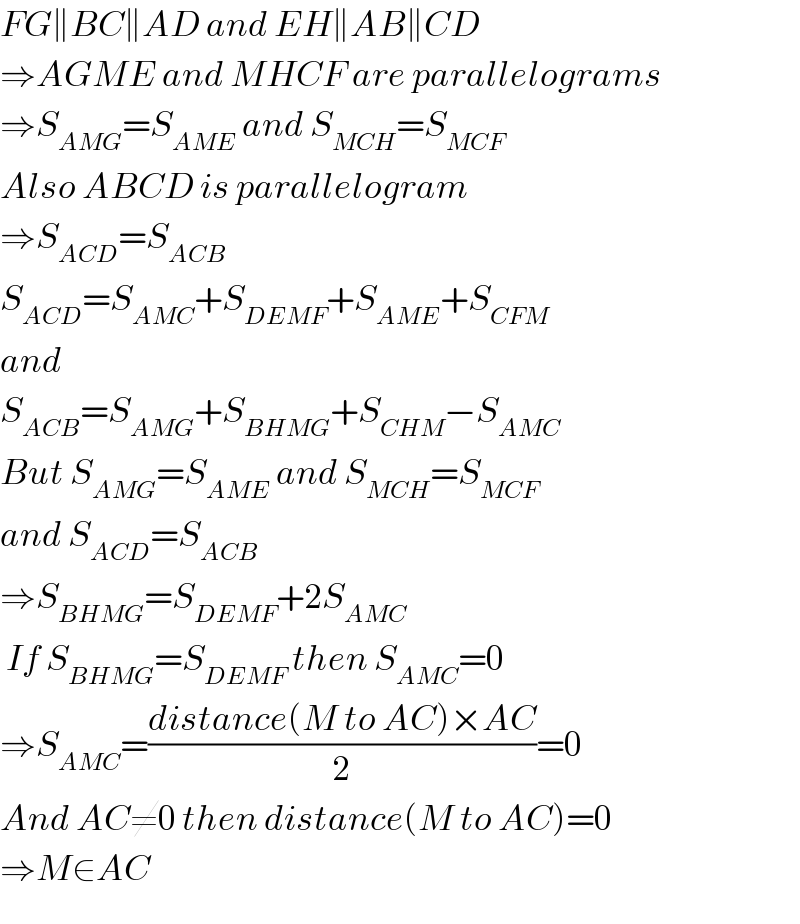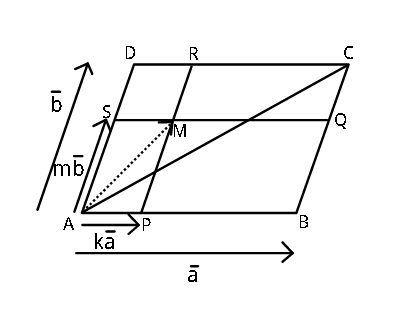
Question Number 17645 by Tinkutara last updated on 09/Jul/17
![Suppose that the point M lying in the interior of the parallelogram ABCD, two parallels to AB and AD are drawn, intersecting the sides of ABCD at the points P, Q, R, S (See Figure). Prove that M lies on the diagonal AC if and only if [MRDS] = [MPBQ].](Q17645.png)
$$\mathrm{Suppose}\:\mathrm{that}\:\mathrm{the}\:\mathrm{point}\:{M}\:\mathrm{lying}\:\mathrm{in}\:\mathrm{the} \\ $$$$\mathrm{interior}\:\mathrm{of}\:\mathrm{the}\:\mathrm{parallelogram}\:{ABCD}, \\ $$$$\mathrm{two}\:\mathrm{parallels}\:\mathrm{to}\:{AB}\:\mathrm{and}\:{AD}\:\mathrm{are}\:\mathrm{drawn}, \\ $$$$\mathrm{intersecting}\:\mathrm{the}\:\mathrm{sides}\:\mathrm{of}\:{ABCD}\:\mathrm{at}\:\mathrm{the} \\ $$$$\mathrm{points}\:{P},\:{Q},\:{R},\:{S}\:\left(\mathrm{See}\:\mathrm{Figure}\right).\:\mathrm{Prove} \\ $$$$\mathrm{that}\:{M}\:\mathrm{lies}\:\mathrm{on}\:\mathrm{the}\:\mathrm{diagonal}\:{AC}\:\mathrm{if}\:\mathrm{and} \\ $$$$\mathrm{only}\:\mathrm{if}\:\left[{MRDS}\right]\:=\:\left[{MPBQ}\right]. \\ $$
Commented by Tinkutara last updated on 09/Jul/17

Answered by alex041103 last updated on 09/Jul/17

$${FG}\parallel{BC}\parallel{AD}\:{and}\:{EH}\parallel{AB}\parallel{CD} \\ $$$$\Rightarrow{AGME}\:{and}\:{MHCF}\:{are}\:{parallelograms} \\ $$$$\Rightarrow{S}_{{AMG}} ={S}_{{AME}} \:{and}\:{S}_{{MCH}} ={S}_{{MCF}} \\ $$$${Also}\:{ABCD}\:{is}\:{parallelogram} \\ $$$$\Rightarrow{S}_{{ACD}} ={S}_{{ACB}} \\ $$$${S}_{{ACD}} ={S}_{{AMC}} +{S}_{{DEMF}} +{S}_{{AME}} +{S}_{{CFM}} \\ $$$${and} \\ $$$${S}_{{ACB}} ={S}_{{AMG}} +{S}_{{BHMG}} +{S}_{{CHM}} −{S}_{{AMC}} \\ $$$${But}\:{S}_{{AMG}} ={S}_{{AME}} \:{and}\:{S}_{{MCH}} ={S}_{{MCF}} \\ $$$${and}\:{S}_{{ACD}} ={S}_{{ACB}} \\ $$$$\Rightarrow{S}_{{BHMG}} ={S}_{{DEMF}} +\mathrm{2}{S}_{{AMC}} \\ $$$$\:{If}\:{S}_{{BHMG}} ={S}_{{DEMF}} \:{then}\:{S}_{{AMC}} =\mathrm{0} \\ $$$$\Rightarrow{S}_{{AMC}} =\frac{{distance}\left({M}\:{to}\:{AC}\right)×{AC}}{\mathrm{2}}=\mathrm{0} \\ $$$${And}\:{AC}\neq\mathrm{0}\:{then}\:{distance}\left({M}\:{to}\:{AC}\right)=\mathrm{0} \\ $$$$\Rightarrow{M}\in{AC} \\ $$
Commented by alex041103 last updated on 09/Jul/17

Commented by Tinkutara last updated on 09/Jul/17

$$\mathrm{Thanks}\:\mathrm{Sir}! \\ $$
Answered by ajfour last updated on 09/Jul/17

Commented by ajfour last updated on 09/Jul/17

$$\mathrm{Area}\:\mathrm{MRDS}=\mathrm{k}\bar {\mathrm{a}}×\left(\bar {\mathrm{b}}−\mathrm{m}\bar {\mathrm{b}}\right) \\ $$$$\:\:\:\:\:\:\:\:\:\:\:\:\:\:\:\:\:\:\:\:\:\:\:\:\:\:=\mathrm{k}\left(\mathrm{1}−\mathrm{m}\right)\bar {\mathrm{a}}×\bar {\mathrm{b}} \\ $$$$\mathrm{Area}\:\mathrm{MPBQ}=\left(\bar {\mathrm{a}}−\mathrm{k}\bar {\mathrm{a}}\right)×\mathrm{m}\bar {\mathrm{b}} \\ $$$$\:\:\:\:\:\:\:\:\:\:\:\:\:\:\:\:\:\:\:\:\:\:\:\:\:\:=\mathrm{m}\left(\mathrm{1}−\mathrm{k}\right)\bar {\mathrm{a}}×\bar {\mathrm{b}} \\ $$$$\:\mathrm{position}\:\mathrm{vector}\:\mathrm{of}\:\mathrm{M}\:: \\ $$$$\:\:\:\:\:\:\:\:\:\:\:\:\:\:\:\:\:\:\:\:\:\:\bar {\mathrm{r}}_{\mathrm{M}} =\:\mathrm{k}\bar {\mathrm{a}}+\mathrm{m}\bar {\mathrm{b}} \\ $$$$\mathrm{when}\:\mathrm{the}\:\mathrm{two}\:\mathrm{areas}\:\mathrm{are}\:\mathrm{equal}, \\ $$$$\:\:\:\:\:\:\:\mathrm{k}\left(\mathrm{1}−\mathrm{m}\right)=\mathrm{m}\left(\mathrm{1}−\mathrm{k}\right) \\ $$$$\:\:\Rightarrow\:\:\:\:\:\:\:\:\:\mathrm{k}=\mathrm{m}\: \\ $$$$\:\:\:\:\mathrm{then}\:\:\:\:\bar {\mathrm{r}}_{\mathrm{M}} =\:\mathrm{k}\left(\bar {\mathrm{a}}+\bar {\mathrm{b}}\right)\:\:\: \\ $$$$\Rightarrow\:\:\:\:\:\mathrm{M}\:\mathrm{is}\:\mathrm{on}\:\mathrm{AC}\:\:\mathrm{then}. \\ $$
Commented by Tinkutara last updated on 09/Jul/17

$$\mathrm{Thanks}\:\mathrm{Sir}! \\ $$
